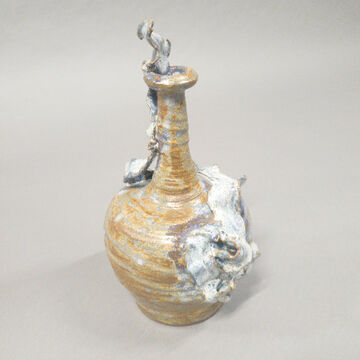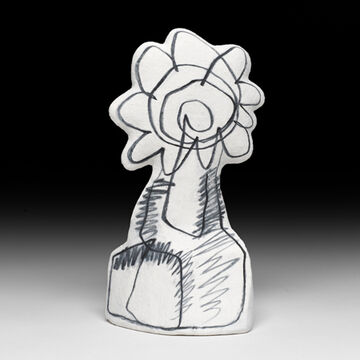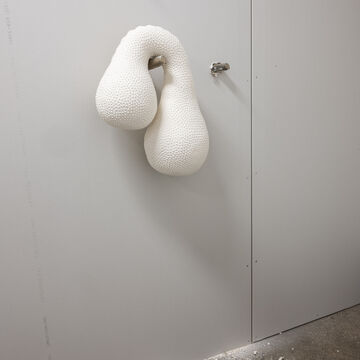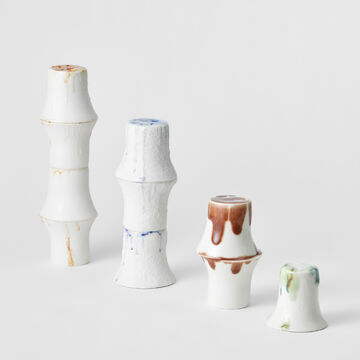
Students
Second-Year Graduates

Jacqueline Saepoff
Personal Statement: I am interested in flipping the power dynamic that exists between artist and material; rather than acting as master and manipulator, I prefer to collaborate with my medium and allow the voice and agency of the material to show through. Inspired by my mystical Jewish upbringing, as well as my lifelong exposure to holistic and ayurvedic principles, I interpret an urgency in my body, similar to an inhaled and held breath, as a nonverbal communication that I am having with the material. I experience the living water that is in my material to be speaking directly to the water in my body, guiding my hand to the shape the material wants to become.
Water holds secrets and truths and is willing to share them with anyone who will listen. My practice is one of listening. I listen to the material, I listen for whatever truths it wants to tell me today, and I listen for what it wants to become. I do this by touch, by hearing the material whisper through my nerves and veins, “notice this” “I want to be bigger/smaller/smoother in this spot.” I feel these things deep inside of me as a building and often sudden urgency, like I inhaled and have been holding my breath.
Much of my work is along the theme of return by way of healing and vice versa. There is a visiting, where I am an observer, partially removed from the experience of living, just here to see what this life is about, and there is a returning, to truth and to who I am, where I come from, and why I am here. My intuitive carving and gestural mark making lead to truths. The final result often appears to be abstracted ideas of what humans consider sublime or natural, but what is true about them is their genuineness. They are not representations of the objects they resemble, but objects themselves that have the effect of often tricking the viewer into seeing a realistic representation of something familiar, when in fact the realness they are attracted to is the life and eternal truth emanating from the genuineness of the gesture. The piece itself is quite abstracted, in that it is made up entirely of gestures and is quite different from the natural object the viewer thinks they are seeing. I trust the material to guide my hand to the mark it wants to have. The gesture is loving and generous.

Ava Carney
Ava Carney is an interdisciplinary artist and ceramicist interested in investigating play and perception as pathways for resilience. In her practice, clay enables slippages between self, material, and object via its mutability and manifests artifacts from the interior and transformative realm of the imagined.
Ava received a BFA from the New York State College of Ceramics at Alfred University in 2017. She is based in Chicago and a current MFA candidate at the School of the Art Institute of Chicago (SAIC). She has held residencies at the Watershed Center for Ceramic Arts, Cité Internationalé des Arts, the Chicago Park District, and YoungArts. Ava has received awards from the Kosciuszko Foundation, the Nova Institute for Health, and YoungArts.
Since 2019, Ava has worked in public service and community engagement, where she coordinates arts programming for Chicago youth in the Teen Services & YOUmedia department at Chicago Public Library.

Matthew Kaufman
Matthew Kaufman is a queer Jewish artist currently residing in Chicago, Illinois. Focusing on discreet parts of the body, Kaufman uses clay to create theatrical sculptures exploring conversations of humor and self-discomfort. By isolating and hyperbolizing body parts, he examines the different registers in which his body is taken up and given significance. The result is a compelling method by which Kaufman negotiates his own bodily insecurity and awareness and puts these affective states in conversation with his viewers. He received a BA in Studio Art and Psychology from Brandeis University and is currently enrolled at the School of the Art Institute of Chicago.

Seunghee Lee
Personal Statement: My work points to "artificiality." The process begins with a question. Even after having received art education for about 10 years in Korea, I always questioned the artificial process and wanted to get out of the typical process. So I started working by comparing the fish on display for sale to my life, which reminded me of what I felt and questioned all this time; living my life to meet other people's standards was not so different from packaged fish, so I had to get out of it. The representative work for showing the theme is Fish Market. Fish Market brings ordinary objects which viewers can see easily in their daily lives and which are transformed into artworks and placed in a special place called an exhibition hall. As a result it evokes artificial moments that viewers pass by indifferently in daily lives. In each artwork, artificial moments are created in the formalized processes of making fish and humans prepared to the needs of others, often suggesting a sense of helplessness. I was influenced by a philosopher named Zhuangzi. According to Zhuangzi, since not applying artificiality means leaving things as they are, artificiality should not be applied for any justification in order for all things to maintain their integrity. However, it is difficult to find anything without the touch of human artificiality in human civilization. The point of my work is to superficially create an artificial state, but paradoxically, to essentially pursue a natural state away from the artificial state.
First-Year Graduates

Sophia Muys
Sophia Muys (she/her) is an interdisciplinary artist from the Bay Area, California. She is interested in how figural work can explore the performance of selfhood. Her practice often responds to representations of femininity in traditionalized forms of portraiture, primarily as found in the history of Western art.
Sophia earned a BA in Art with a minor in Art History from UCLA in 2022, and has since worked as an artist in Los Angeles and the Bay Area.

Autumn Horwath
Autumn Horwath is a sculptor working in clay, metal, wood and fibers. She received a BFA in Art Education from Belmont University in Nashville, TN, then did a year of graduate studies in Sculpture at the University of Wisconsin-Milwaukee. She taught Ceramics at a public junior high school in Utah and misses her rowdy students. Horwath was an Educational Fellow at the Archie Bray Foundation for the Ceramic Arts, and has shown work at James May Gallery, Var Gallery, Trout Museum of Art, and Racine Art Museum. Currently she is a MFA Candidate in Ceramics at the School of the Art Institute Chicago.
Personal Statement: I always wanted to be a cowboygirl. When I would state this as a kid, my parents tried to correct me by saying (not asking), 'You mean a cowgirl.' 'No?' I would respond. 'A cowboygirl.'
In the 90s, cowboys were the real deal, they were the ones tearing up dust in western movies or riding bulls in the rodeo. Cowgirls were pin-ups on pastel colored advertisements. With my cowboy hat and cowboy boots I knew I needed to be taken seriously so I refused the paradigm.
Today, it would still be nice to be taken seriously, but I’ve lowered my expectations.

Christina Lee
Christina Lee (she/her) is a ceramic artist currently based in Chicago, IL. She earned a BFA in Ceramic Art from Kyunghee University (South Korea) in 2021. From 2021 to 2023, she served as an assistant curator at Gallery Kabinett (South Korea), gaining extensive experience in exhibition management. She is currently an MFA candidate at the School of the Art Institute of Chicago.
Through her ceramics, Christina Lee explores a deep reflection of her inner essence, shaped by both intrinsic energies and external influences. Her recent work, The Columns (2023), is inspired by the ever-changing abstract emotions she experiences. She translates these feelings into tangible, physical forms represented by ceramic columns. Utilizing the dynamic interplay between clay and glaze, where contingency and permanence coexist, Christina aspires to deepen her understanding of her inner world and communicate this understanding to the broader world. Her artwork offers a fresh perspective on interpreting the inner and outer realms of individuals.

Henry Tyson
As a queer and self reflective artist, Henry Tyson (they/them) seeks processes and mediums that record and bolster the questions they ask of others and themself. The malleability of wet clay and the permanence of its fired state have directed Tyson through investigations of queer embodiment, what it means to inhabit a body, how we move within our forms, and how they move us. Henry finds sculpting clay profoundly tactile and gratifying; the practice affords the artist agency over the forms and bodies they create. As a nonbinary person who often feels disconnected from bodily experiences, agency is refreshing. Using their hands to shape a body is intimate and technical; knowing that their thumbprint with the right pressure and angle creates an anatomically convincing xiphoid process is exhilarating and euphoric. Tyson focuses on figurative studies—never working from live models and rarely from reference images—to learn about their own body. Clay has taught them that human bodies do not have templates; they fold and bend and twist and differ and break. Tyson explores the contrapposto and classical forms through a queer lens to ask why we gender physical characteristics. The artist encourages the viewer to be similarly inquisitive, and often omit faces or heads in their art so one may project their own feelings and questions onto it. Tyson's works ask the viewer: how may we question our assumptions about bodies? How do we feel about our own?

Maya Jackson
Personal Statement: I am a ceramic artist whose work is both functional and sculptural dealing with ideas of identity, ancestry, and nature. My personal experiences as an African-American bi-racial woman in the US coupled with what I’ve learned about the lived experiences of others, notably through my work at non-profit organizations, inspire me to create art that conveys my perspective on the world or speaks to societal issues. I come from a privileged background and this has allowed me to see the many disparities in our society from a unique angle. As someone who takes up space where other black women do not, while simultaneously being silenced in privileged spaces, I am driven to make ceramics more accessible.
My work explores the relationship between the body, nature, and disruptive forces, inspired by my lived experience. What began as a goal to create a planter to hold my not-yet-potted houseplants evolved into an exploration of my ancestry, research on the history of how my facial features came to be, and a call to mindfulness. My work is an ode to Black womanhood and my forms often combine elements of the natural world, like plants, to celebrate Black hair in its natural state. The incorporation of plants in my sculptures not only represents the beauty, complexity, and diversity of Black hair, but also Black thought. I investigate how unnatural and disruptive forces like systems of oppression interrupt the beauty of nature, often creating alternative depictions of beauty.
Disclaimer: All work represents the views of the individual artists and authors who created them, and are not those of the School or museum.